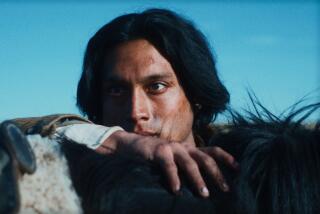Massacre on the Gila<i> by Clifton B. Kroeber and Bernard L. Fontana (University of Arizona: $26.50; 232 pp.) </i>
- Share via
American Indian tribal wars began centuries before the first Europeans rode into view and lasted until late in the 19th Century. In 1873, for example, eight years after the great white intertribal brouhaha concluded at Appomattox, the Sioux were still battling the Pawnee.
“Massacre on the Gila” describes an attack by Quechan and Mohave warriors on a Maricopa village in southern Arizona in 1857--the last intertribal fight in the Southwest. A small party of whites employed by the San Antonio and San Diego Mail Line was encamped at Maricopa Wells just a few hundred yards from the battleground, and one of these men, Isaiah Churchill Woods, kept a journal. His entry for Sept. 1 contains the only eyewitness report. Woods, who sat under a tree watching what happened from start to finish, realized that he was seeing “the largest Indian battle of the times,” but he summarized it in two paragraphs. More important from his point of view was a wagonload of mail destined for San Diego.
Authors Clifton B. Kroeber and Bernard L. Fontana have included other mentions of the battle--government reports, newspaper stories, letters, Indian recollections--but altogether, there isn’t much documentation. Several hundred warriors were involved, perhaps as m1634629920with 93 of his warriors were killed within half an hour--presumably clubbed to death. Years afterward, there were assertions that rifles were used by Pima neighbors who joined the Maricopa, although contemporary accounts do not substantiate this. Many warriors fought with bow and arrow, but the basic weapon of tribes in this area was a club, very often carved from mesquite or ironwood, heavy enough to crack somebody’s skull yet light enough that a warrior could swing it quickly. Knives made of stone or fire-hardened sticks were used at close quarters. Fighting men usually carried a sheepskin or buckskin shield.
The antagonists--all except the Pima--spoke mutually intelligible dialects of the Yuman language, and their ways of life were similar. Their forms of government, religion, economics and social structure differed only in detail. In effect, they were cousins. These Indians were so much alike that warriors had trouble distinguishing friends and allies from enemies. The Quechan, for instance, plastered mud on their faces and drew figures in the mud to identify themselves.
So, considering this battle at Maricopa Wells from the distance of more than a century, remembering that the participants were linguistically and socially related and needed some sort of distinctive costume or facial design in order to avoid bashing or stabbing comrades, the whole thing appears senseless, almost absurd.
Isaiah Woods’ reference to a young, ambitious chief suggests the principal theme of “Massacre on the Gila,” which is not the study of one particular fight between Arizona Indians so much as it is a discourse on the origins, motives and concepts of human warfare.
Kroeber and Fontana believe that this quintessentially male preoccupation evolved from isolated prehistoric skirmishes into a universal nightmare because of “an imbalance in the sex division of valued status positions within a society.” Warriors who assaulted the Maricopa village came from a fertile agricultural region on the lower Colorado where life was so easy that women could do all the work, leaving the men with too much leisure time: “Or, put another way, males were potentially all but useless. Given these circumstances, it is small wonder that they developed warfare to a high degree. It was a way they could maintain their dignity as human beings.” In this instance, Quechan and Mohave warriors had walked 160 miles through the desert to reassert their masculinity.
Maricopa males, by contrast, had plenty to do at home. They hunted, dug irrigation ditches, held religious ceremonies, and harvested domestic crops. Because they felt confident, knowing they had a place in society, they felt no special need to pose as warriors.
Kroeber, who is a professor of history, and Fontana, a cultural anthropologist, prudently qualify their hypothesis. They quote from the work of other social scientists with differing ideas, and they provide various explanations for this singular attack.
Capt. H. S. Burton, commandant of Ft. Yuma at the time, said it was because five Yuma had joined some Tonto Apache in a raid upon the Maricopa several months earlier, whereupon the Maricopa retaliated--killing 16 Tonto and taking three children prisoners--an event which quite naturally demanded retaliation. Lt. Joseph C. Ives met a Quechan survivor and concluded, probably on the basis of what this man said, that in 1856, a dying Yuma chief had urged his people to destroy the wicked Maricopa.
The comment of anthropologist (and author Clifton Kroeber’s father) Alfred L. Kroeber is disturbing in its relevance to our present worldwide Angst: “Where fighting is involved, motivation becomes particularly elusive. The main thing seems to be that there should be war. . . . There is often a sense of foreboding or of the inevitability of what will happen.”
Despite the rousing battle scene with which this book opens, “Massacre on the Gila” is an exploration of a much larger phenomenon. The narrative style is dulled by academic locution, but Kroeber and Fontana are meticulous professionals. Their study of this neglected slice of Southwestern history deserves applause.
More to Read
Sign up for Essential California
The most important California stories and recommendations in your inbox every morning.
You may occasionally receive promotional content from the Los Angeles Times.








